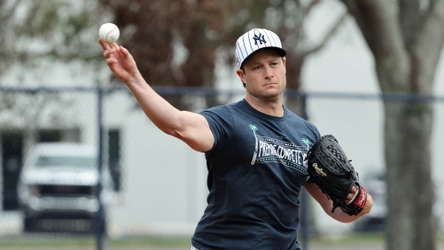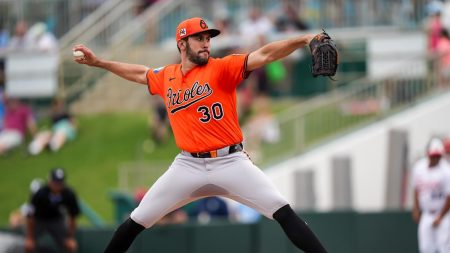The Phenomenon of Paul Skenes
SARASOTA, Fla. — The magic of Paul Skenes is impossible to miss. The 6-foot-7 superstar pitcher from Pittsburgh commands attention with his towering presence and extraordinary velocity, making him a magnetic figure on the mound. Even without a deep understanding of pitching mechanics, the average fan can appreciate the sheer entertainment value of watching Skenes deliver a fastball that seems to leave his hand in a blur and lands with a resounding pop in the catcher’s mitt. His pitching motion is as unique as it is powerful, a blend of brute force and finesse that often leaves observers in awe. Skenes is a force of nature, a pitcher whose every appearance is a spectacle, and his 2024 NL Rookie of the Year season only heightened the anticipation surrounding his outings. Whether it’s a spring training game in March or a high-stakes playoff match in September, Skenes is always the main event.
Spring Training: A Time for Experimentation
On a chilly Thursday evening in Florida, Skenes took the mound for his second spring training start against the Baltimore Orioles, unveiling two brand new pitches: a two-seam fastball and a cutter. Despite the cooler temperatures, the atmosphere was electric as fans gathered around the visitors’ bullpen, eager to catch a glimpse of the young ace warming up. As Skenes began his routine, his high 90s fastballs drew gasps and comments from the crowd, including a wide-eyed 10-year-old who remarked, "Dad, I don’t think I’d be able to hit that." During his bullpen session, Skenes appeared to work through a repertoire of five different offerings, including the two new pitches. The game, however, was not broadcast on television or tracked by MLB’s public-facing Statcast system, leaving most of the specifics to the unreliable jumbotron radar gun. For Skenes, this was just another opportunity to tinker and test, a hallmark of spring training for many pitchers.
Expanding the Arsenal
Skenes’ decision to add new pitches might seem counterintuitive given his already dominant arsenal. Last season, he relied heavily on his four-seam fastball, slider, and a devastating pitch known as the "splinker," which is a blend of a splitter and a sinker. These three pitches, combined with his elite velocity and deception, made him nearly unhittable, as evidenced by his microscopic 1.99 ERA. Yet, Skenes is not content to rest on his laurels. "Really, [I’m] just trying to create more swing decisions,” he told MLB.com’s Alex Stumpf last month. The two-seam fastball, in particular, is designed to address a specific weakness in his pitch location against right-handed batters in two-strike counts. The heatmap of his pitch location shows a noticeable gap on the inner third of the plate, an area where the two-seamer, with its tailing action, can be particularly effective. By adding this pitch, Skenes aims to keep hitters guessing and off-balance.
The Cutter: A New Dimension
The cutter, which Skenes threw in the 90-92 mph range with a slight gloveside break during his recent outing, is an even more intriguing addition to his arsenal. While it might not seem as immediately necessary as the two-seamer, the cutter fills a crucial velocity gap. Skenes’ slider and sweeper, which have similar movement patterns, are thrown at lower velocities, around 85 mph. The new cutter provides a pitch in the higher 90s range, giving Skenes a versatile tool to use in various situations. When asked about the utility of the cutter, Skenes explained, "I didn’t have anything like that before and it was kind of like, ‘Well, I throw 100, why don’t I throw a 90 mile-an-hour slider, basically?’ Why don’t I throw a breaking ball that’s around 90? Because I can." This pitch not only adds a new dimension to his game but also complements his existing offerings, ensuring that his overall pitching strategy remains unpredictable and challenging for hitters.
Skepticism and Support
Despite the obvious benefits of adding new pitches, some within the baseball community have expressed skepticism. The concern is not about the quality of the new pitches—most agree that anything Skenes uses will likely grade out well due to his exceptional velocity and control—but rather about the potential reduction in the usage of his most dominant pitches. By introducing the two-seamer and cutter, Skenes might toss his four-seamer, slider, and splinker less frequently, which could give hitters a slight advantage. The idea is that if the probability of facing a 100 mph fastball or a game-changing splinker decreases, hitters might gain some confidence at the plate. However, Skenes’ counterargument is compelling. He believes that the added unpredictability of his pitching is more valuable than the slight reduction in the frequency of his most dominant pitches. "More pitches means more decisions and more decisions mean more discomfort. All of which is good for Skenes," he reasoned.
The Future of Skenes’ Pitching
As Skenes continues to refine his new pitches, the baseball world will be watching with bated breath. The effectiveness and frequency of the two-seam fastball and cutter in his regular-season starts remain to be seen, but the early signs are promising. Skenes’ commitment to experimentation and improvement is a testament to his dedication and competitive drive. Whether these new pitches become staples in his arsenal or remain occasional tools, the fact that Skenes is constantly striving to outdo himself is a thrilling prospect for fans and analysts alike. His next start, scheduled for March 11 against the New York Yankees, will provide the first detailed data on the new pitches, and it promises to be must-see TV. After all, when it comes to Paul Skenes, the show is always worth tuning in for.










